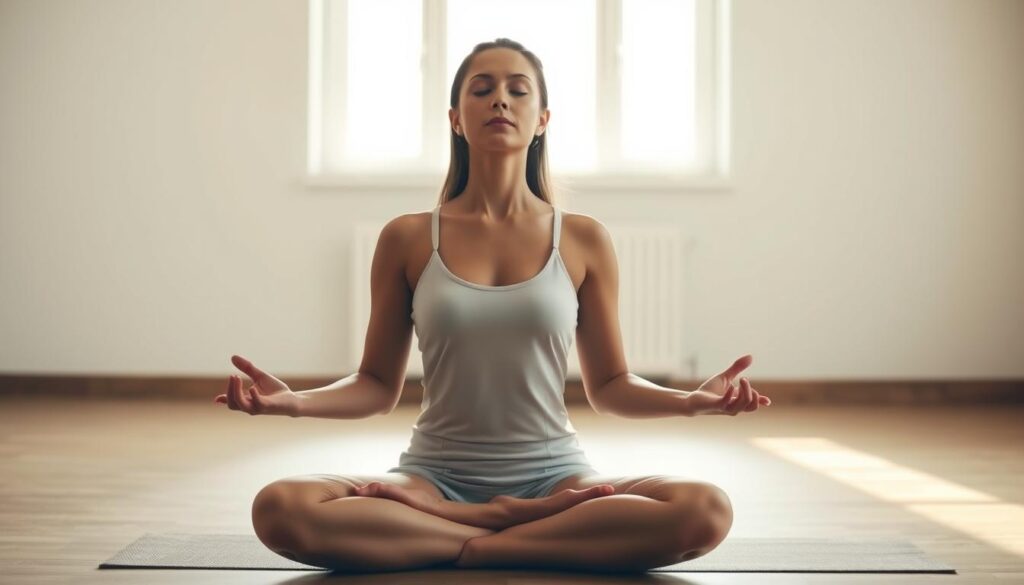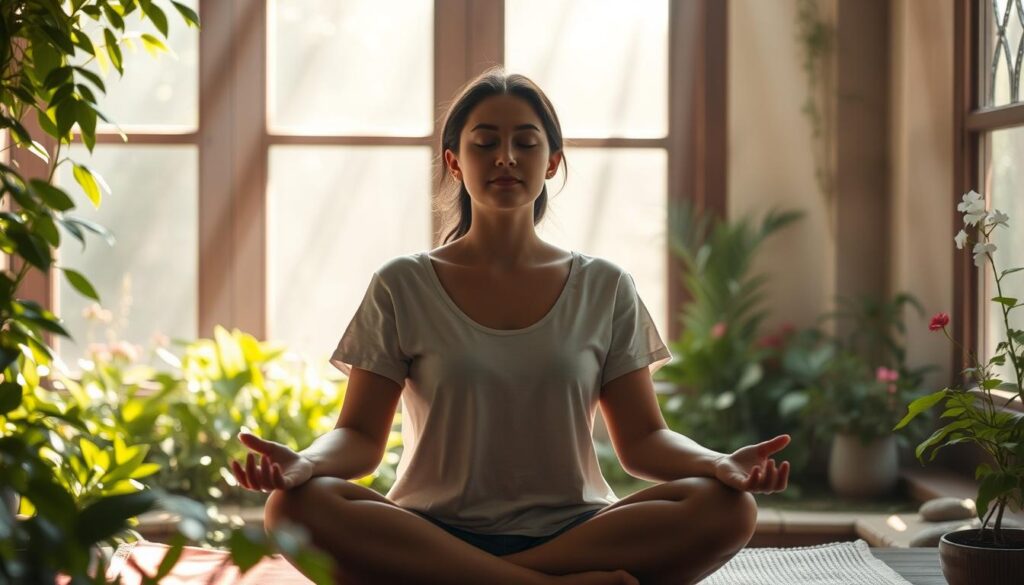I still remember the first time I tried meditation – it was a game-changer. As a busy professional, I was skeptical at first, but I was desperate for a way to calm my mind and reduce stress. To my surprise, it wasn’t about achieving perfect stillness or emptying my mind completely; it was about being present in the moment.
Meditation has come a long way from its ancient roots, evolving into a practical tool for modern life. With mindfulness at its core, this practice has become accessible to everyone, regardless of background or experience. By incorporating meditation into our daily routine, we can experience numerous benefits, from reduced stress to improved focus.
In this article, we’ll explore the various ways to meditate and find what works best for you. Whether you’re a seasoned practitioner or just starting out, our goal is to help you discover the power of meditation and mindfulness in enhancing your overall well-being.
Key Takeaways
- Understanding the concept of meditation as a versatile practice
- Exploring the evolution of meditation and its benefits
- Addressing common misconceptions about meditation
- Discovering different techniques to enhance mindfulness
- Learning how to incorporate meditation into daily life
Understanding Meditation and Its Benefits
Meditation, at its core, is a practice that can be tailored to anyone’s needs, providing a wide range of benefits for both the mind and body. It is a technique that involves focusing the mind to achieve a state of calm and clarity.
What Is Meditation?
Meditation is a practice that involves focusing the mind to achieve mental clarity and emotional calm. It is not about emptying the mind but rather about observing thoughts without judgment. When we meditate, we cultivate mindfulness and awareness, which can be achieved by concentrating on the breath, which serves as an anchor.
Through regular meditation practice, we can train our minds to be more resilient, improving our overall health and well-being.
The Science-Backed Benefits of Regular Practice
Research has shown that regular meditation practice can bring numerous benefits, including reduced blood pressure, improved immune function, and better sleep quality. These physical benefits are complemented by psychological benefits, such as stress reduction, improved emotional regulation, and increased focus.
- Physical benefits: reduced blood pressure, improved immune function, and better sleep quality
- Psychological benefits: stress reduction, improved emotional regulation, and increased focus
Moreover, meditation can be a complementary approach to managing various health conditions like anxiety, depression, and chronic pain. By incorporating meditation into our daily routine, we can experience these benefits firsthand and improve our overall well-being.
Getting Started with Meditation
Starting a meditation practice can seem daunting, but with a few simple steps, you can set yourself up for success. The key is to create an environment that fosters calmness and serenity, allowing you to focus on your meditation practice.
Creating the Right Environment
Find a place to sit that feels calm and quiet to you. It doesn’t have to be perfect; even a corner of a busy room can work if that’s what you have available. The goal is to minimize distractions, so you can focus on your breath and the present moment. Consider using a cushion or chair that supports your back, and keep the space tidy to promote a sense of calm.
Posture and Positioning
When it comes to meditation posture, there’s no one-size-fits-all solution. You can meditate on a chair, on a cushion on the floor, or even on a kneeling bench. The most important thing is to find a position that’s comfortable for your body and allows you to relax while remaining alert. Experiment with different options to find what works best for you, taking time to adjust and settle into your chosen position.
Setting Realistic Expectations
If you’re just beginning, it’s helpful to start with a short time, such as five or 10 minutes a day. Consistency is more important than duration, so aim to meditate at the same time every day, even if it’s just for a few minutes. This will help you build a sustainable habit and make meditation a part of your daily routine, allowing you to experience the benefits of regular meditation practice.
Mindfulness Meditation: The Foundation Practice
As the most researched and practiced form of meditation in the West, mindfulness meditation offers a straightforward yet powerful way to cultivate awareness of the present moment. Originating from Buddhist teachings, this practice has become a cornerstone of modern mindfulness practices, helping individuals develop a greater understanding of their thoughts and emotions.
Step-by-Step Guide to Mindfulness
To practice mindfulness meditation, start by finding a quiet and comfortable spot to sit, either on a chair or on a cushion on the floor. Close your eyes and take a few deep breaths to calm your body and mind. Bring your attention to your breath, feeling the sensation of the air entering and leaving your nostrils. When your mind wanders (and it will!), gently acknowledge the thoughts and let them go, returning your focus to your breath. Start with short sessions of 5-10 minutes and gradually increase the duration as you become more comfortable with the practice.
Common Challenges and How to Overcome Them
As you begin your mindfulness meditation journey, you may encounter challenges such as mind-wandering, restlessness, or sleepiness. These are normal experiences that many meditators face. To overcome them, try to be patient and kind to yourself. When your mind wanders, gently bring your attention back to your breath without judgment. If you’re feeling restless, try to relax your body and focus on the sensation of your feet touching the ground. And if you’re getting sleepy, a short walk or a change in posture can help. Remember, the goal of mindfulness meditation isn’t to achieve a specific state but to cultivate awareness of the present moment with kindness and curiosity.
“The mind is everything; what you think, you become.” – Buddha
| Challenge | Solution |
|---|---|
| Mind-wandering | Gently bring attention back to breath |
| Restlessness | Relax body, focus on feet touching ground |
| Sleepiness | Take a short walk, change posture |
Breath-Focused Techniques in Meditation

The breath is a versatile tool in meditation, serving as a focal point that can be explored in multiple ways. By focusing on the breath, individuals can cultivate a deeper sense of awareness and calm.
Basic Breath Awareness
Basic breath awareness involves observing the natural rhythm of your breathing without attempting to control it. Focus on the sensation of the breath moving in and out of the body, noticing where you feel it most – whether in the belly, nose, or chest. This technique helps in developing mindfulness and can be a powerful tool for reducing stress.
Counted Breathing
Counted breathing is a technique that involves counting the breaths to maintain focus. You can count up to a certain number (like 10) and then start over, or count down from a number. This technique is particularly helpful for those who find their minds wandering frequently. Variations of counted breathing can be used for different needs, such as stress reduction or energy boosting.
Deep Breathing Exercises
Deep breathing exercises involve taking slow, deep breaths into the lungs, often through the nose and out through the mouth. This can have a profound effect on the nervous system, helping to calm the body and mind. Deep breathing can be used in conjunction with other meditation techniques to enhance relaxation and reduce anxiety.
Body-Based Meditation Practices
For many of us, connecting with our body through meditation can be a more accessible entry point than focusing on our thoughts. This is because we can directly experience physical sensations, making it easier to cultivate mindfulness. Body-based practices can be particularly helpful for people dealing with physical pain, body image issues, or those who spend long hours at desks disconnected from bodily sensations.
Body Scan Meditation
Body scan meditation involves systematically moving our attention through the body, observing physical sensations without judgment. As we focus on different areas, we can release tension held in various parts of our body. This practice helps develop bodily awareness and can be a powerful tool for relaxation.

Progressive Muscle Relaxation
Progressive muscle relaxation is a technique that involves tensing and then relaxing different muscle groups. By doing so, we can release physical tension and promote relaxation. This practice can be used as a standalone meditation or as a complement to other techniques, enhancing our overall mindfulness practice.
Movement Meditation: Yoga, Tai Chi, and Walking
Movement meditations like yoga, tai chi, and walking meditation bring meditative awareness to our everyday movements. By focusing on the sensations in our body as we move, we can cultivate mindfulness in our daily activities. These practices help us stay connected to our bodies, promoting a sense of well-being and reducing stress.
Sound and Mantra Meditation
Sound and mantra meditation offer a refreshing alternative to traditional breath-focused practices, using sound to anchor the mind. This approach can be particularly helpful for those who find it challenging to maintain focus through breath alone.
Using Mantras for Focus
Mantra meditation involves the repetition of a word, phrase, or sound to clear the mind and cultivate specific qualities such as compassion or clarity. The mantra can be a traditional Sanskrit syllable or a modern affirmation, making this practice accessible to everyone. For instance, the mantra “om” is widely used in various meditation traditions, including Hindu and Buddhist practices.
Sound Bath Meditation
Sound bath meditation utilizes instruments like singing bowls, gongs, and chimes to create vibrations that induce meditative states. This practice is particularly effective for processing emotions and developing compassion. By immersing oneself in the healing sounds, individuals can achieve a deep state of relaxation and inner peace.
| Meditation Technique | Primary Focus | Benefits |
|---|---|---|
| Mantra Meditation | Repetition of sound or phrase | Enhances focus, cultivates compassion |
| Sound Bath Meditation | Immersive sound experience | Deep relaxation, emotional healing |
Incorporating sound into meditation practice can significantly enhance one’s mindfulness journey, offering a versatile and engaging way to deepen one’s meditation experience.
Visualization and Contemplative Practices
Visualization and contemplative practices offer a unique approach to meditation, engaging our creative and emotional selves. These techniques are particularly effective for individuals who are visually oriented or are dealing with specific emotional challenges. By leveraging the imagination, we can cultivate a deeper sense of relaxation, peace, and overall well-being.
Guided Imagery Techniques
Guided imagery involves creating vivid mental scenes that engage all the senses, promoting a state of deep relaxation and reducing stress. To practice guided imagery, start by finding a quiet and comfortable space where you can relax without distractions. Close your eyes and begin to visualize a peaceful scene – it could be a serene beach, a tranquil forest, or a mountain meadow. Use all your senses to bring the scene to life: notice the sights, sounds, smells, and sensations in your body. Regular practice can enhance stress reduction, pain management, and even performance enhancement. You can tailor your visualization to address specific needs, such as healing visualizations for physical or emotional recovery.

Loving-Kindness Meditation
Loving-kindness meditation is a systematic practice aimed at cultivating compassion and kindness towards oneself and others. It begins with directing well-wishes towards yourself, then gradually extends to include friends, acquaintances, and even those you may have difficulty with. The practice involves repeating phrases such as “May I be happy, may I be healthy, may I be at peace” and extending them to others. This practice helps in developing a sense of connection and empathy. By practicing loving-kindness meditation, you can foster a more positive and compassionate mindset, leading to greater emotional resilience and well-being.
Specialized Meditation Traditions
Beyond general mindfulness practices, specialized meditation traditions offer distinct methods for cultivating mental clarity and inner peace. These traditions have evolved over centuries, shaped by cultural, spiritual, and philosophical contexts.
Transcendental Meditation
Transcendental Meditation (TM) is a mantra-based technique that has been extensively studied in the scientific community. This practice involves the use of a personalized mantra to quiet the mind and access a deeper state of consciousness. Research has shown that regular TM practice can lead to reduced stress and anxiety, improved cognitive function, and enhanced overall well-being. To learn TM, one must receive instruction from a certified teacher, ensuring a proper understanding and application of the technique.
Zen Meditation
Zen meditation, also known as Zazen, emphasizes the importance of posture and the concept of “just sitting” without striving for specific outcomes. This practice is rooted in Buddhist philosophy, focusing on the attainment of insight through direct experience rather than scripture or doctrine. Zen meditation encourages practitioners to cultivate a mindset of openness and curiosity, allowing them to approach life with greater clarity and equanimity. For more on various meditation techniques, including Zen, visit Headspace’s meditation techniques page.
Spiritual and Religious Meditation Practices
Various spiritual and religious traditions incorporate meditation into their practices, including Christian contemplative prayer, Islamic dhikr, Jewish hitbodedut, and yogic practices. These practices share common elements, such as the use of prayer, mantra, or focused attention to cultivate a deeper connection with the divine or a higher self. When engaging with these traditional practices, it’s essential to approach them with respect and an understanding of their cultural context. By doing so, individuals can enrich their meditation practice and foster greater empathy and understanding across different spiritual traditions.
- Meditation traditions offer unique approaches to mental and spiritual growth.
- Practices like TM and Zen meditation provide structured techniques for cultivating mindfulness and inner peace.
- Spiritual and religious meditation practices can deepen one’s connection with their faith and foster a sense of community.
Conclusion: Building a Sustainable Meditation Practice
Meditation is not a one-size-fits-all practice, and finding what works best for you is key to making it a sustainable part of your life
As we’ve explored throughout this article, there are numerous ways to meditate, from mindfulness meditation to body scan and movement meditation. The key is to experiment with different techniques to find what brings you the most benefits and helps you manage stress effectively.
To build a consistent practice, start by setting realistic expectations and making meditation a part of your daily life – it could be during your morning routine, before a meal, or as you walk or eat mindfully. Overcoming obstacles like inconsistency and boredom is crucial; joining meditation groups or using meditation apps can provide the necessary support and motivation.
Remember, the benefits of meditation extend beyond formal practice, enhancing your overall life by promoting mindfulness in everyday activities. As you continue on this journey, approach it with curiosity and self-compassion, and you will find that it becomes a truly sustainable and enjoyable part of your daily routine.
FAQ
What is the best way to start a daily practice of mindfulness?
Start small – just a few minutes a day, focusing on your breath or a simple body scan, can make a big difference in your life.
How can I stay focused during a meditation practice?
Gently bring your attention back to your chosen focus, like your breath, without judging yourself – it’s a normal part of the process.
Can meditation really help reduce stress and anxiety?
Yes, regular practice has been shown to lower stress levels and help manage anxiety by promoting relaxation and reducing tension.
What is body scan, and how do I practice it?
Bring awareness to different parts of your body, starting from your toes and moving up to your head, noticing any sensations or tension.
How can I make meditation a part of my daily life?
Try to practice at the same time every day, like right after waking up or before bed, and make it a habit.
Can I practice mindfulness while doing other activities?
Yes, you can bring mindfulness into your daily activities like eating, walking, or even doing chores by focusing on the present moment.
What are some common challenges people face when starting a meditation practice?
Some common challenges include feeling like you’re not doing it right, having a hard time staying focused, or feeling too stressed to relax.
How can I deal with emotions that come up during meditation?
Observe your emotions with compassion, allowing yourself to feel them without judgment, and remember that it’s okay to experience a range of emotions.
Can meditation help improve my sleep?
Yes, practicing meditation can help you relax and prepare your mind and body for better sleep.
Is it better to meditate for a short time every day or for a longer time less often?
Consistency is key, so even a short daily practice can be more beneficial than longer, less frequent sessions.
